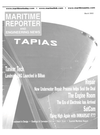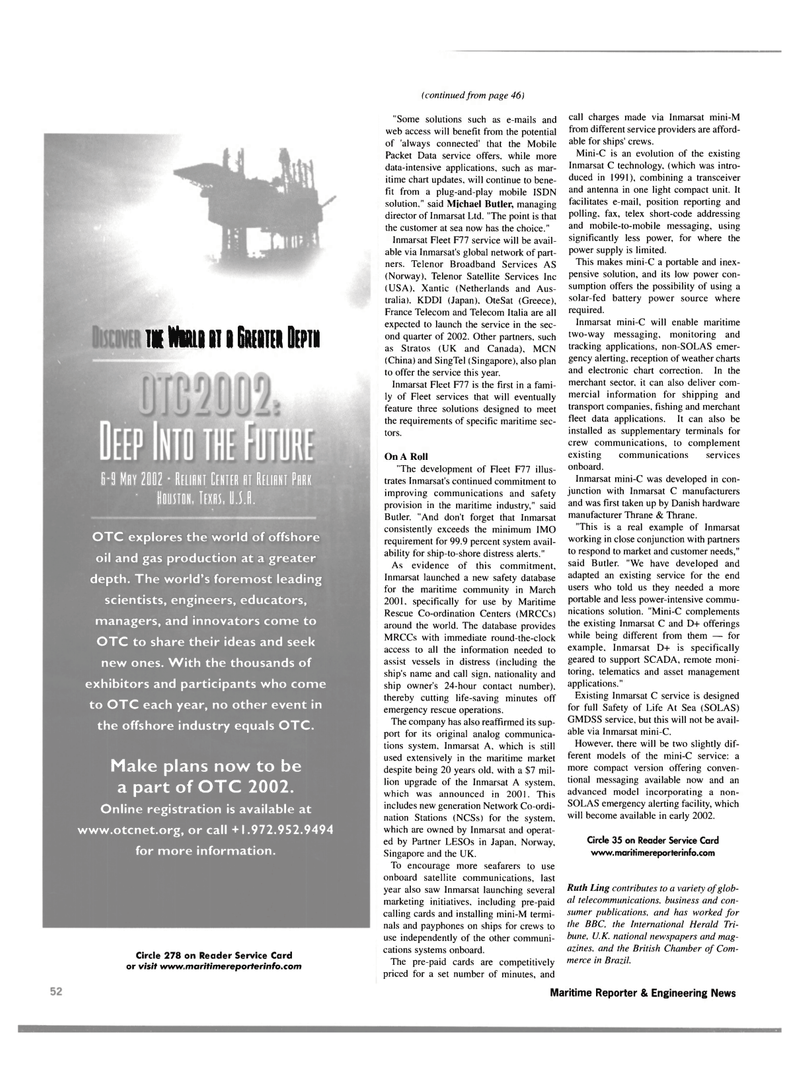
Page 52: of Maritime Reporter Magazine (March 2002)
Read this page in Pdf, Flash or Html5 edition of March 2002 Maritime Reporter Magazine
(continued from page 46) ik Wmii ii i Sunn ton
G-8 May 2(102 • Reliant Center at Reliant Park • Houston, Texas. U1
OTC explores the world of offshore oil and gas production at a greater depth. The world's foremost leading scientists, engineers, educators, managers, and innovators come to
OTC to share their ideas and seek new ones. With the thousands of exhibitors and participants who come to OTC each year, no other event in the offshore industry equals OTC.
Make plans now to be a part of OTC 2002.
Online registration is available at www.otcnet.org, or call +1.972.952.9494 for more information.
Circle 278 on Reader Service Card or visit www.maritimereporterinfo.com "Some solutions such as e-mails and web access will benefit from the potential of 'always connected' that the Mobile
Packet Data service offers, while more data-intensive applications, such as mar- itime chart updates, will continue to bene- fit from a plug-and-play mobile ISDN solution." said Michael Butler, managing director of Inmarsat Ltd. "The point is that the customer at sea now has the choice."
Inmarsat Fleet F77 service will be avail- able via Inmarsat's global network of part- ners. Telenor Broadband Services AS (Norway), Telenor Satellite Services Inc (USA). Xantic (Netherlands and Aus- tralia!. KDDI (Japan). OteSat (Greece),
France Telecom and Telecom Italia are all expected to launch the service in the sec- ond quarter of 2002. Other partners, such as Stratos (UK and Canada), MCN (China) and SingTel (Singapore), also plan to offer the service this year.
Inmarsat Fleet F77 is the first in a fami- ly of Fleet services that will eventually feature three solutions designed to meet the requirements of specific maritime sec- tors.
On A Roll "The development of Fleet F77 illus- trates Inmarsat's continued commitment to improving communications and safety provision in the maritime industry," said
Butler. "And don't forget that Inmarsat consistently exceeds the minimum IMO requirement for 99.9 percent system avail- ability for ship-to-shore distress alerts."
As evidence of this commitment,
Inmarsat launched a new safety database for the maritime community in March 2001. specifically for use by Maritime
Rescue Co-ordination Centers (MRCCs) around the world. The database provides
MRCCs with immediate round-the-clock access to all the information needed to assist vessels in distress (including the ship's name and call sign, nationality and ship owner's 24-hour contact number), thereby cutting life-saving minutes off emergency rescue operations.
The company has also reaffirmed its sup- port for its original analog communica- tions system. Inmarsat A, which is still used extensively in the maritime market despite being 20 years old. with a $7 mil- lion upgrade of the Inmarsat A system, which was announced in 2001. This includes new generation Network Co-ordi- nation Stations (NCSs) for the system, which are owned by Inmarsat and operat- ed by Partner LESOs in Japan, Norway,
Singapore and the UK.
To encourage more seafarers to use onboard satellite communications, last year also saw Inmarsat launching several marketing initiatives, including pre-paid calling cards and installing mini-M termi- nals and payphones on ships for crews to use independently of the other communi- cations systems onboard.
The pre-paid cards are competitively priced for a set number of minutes, and call charges made via Inmarsat mini-M from different service providers are afford- able for ships' crews.
Mini-C is an evolution of the existing
Inmarsat C technology, (which was intro- duced in 1991), combining a transceiver and antenna in one light compact unit. It facilitates e-mail, position reporting and polling, fax, telex short-code addressing and mobile-to-mobile messaging, using significantly less power, for where the power supply is limited.
This makes mini-C a portable and inex- pensive solution, and its low power con- sumption offers the possibility of using a solar-fed battery power source where required.
Inmarsat mini-C will enable maritime two-way messaging, monitoring and tracking applications, non-SOLAS emer- gency alerting, reception of weather charts and electronic chart correction. In the merchant sector, it can also deliver com- mercial information for shipping and transport companies, fishing and merchant fleet data applications. It can also be installed as supplementary terminals for crew communications, to complement existing communications services onboard.
Inmarsat mini-C was developed in con- junction with Inmarsat C manufacturers and was first taken up by Danish hardware manufacturer Thrane & Thrane. "This is a real example of Inmarsat working in close conjunction with partners to respond to market and customer needs," said Butler. "We have developed and adapted an existing service for the end users who told us they needed a more portable and less power-intensive commu- nications solution. "Mini-C complements the existing Inmarsat C and D+ offerings while being different from them — for example, Inmarsat D+ is specifically geared to support SCADA, remote moni- toring, telematics and asset management applications."
Existing Inmarsat C service is designed for full Safety of Life At Sea (SOLAS)
GMDSS service, but this will not be avail- able via Inmarsat mini-C.
However, there will be two slightly dif- ferent models of the mini-C service: a more compact version offering conven- tional messaging available now and an advanced model incorporating a non-
SOLAS emergency alerting facility, which will become available in early 2002.
Circle 35 on Reader Service Card www.mariHmereporterinfo.com
Ruth Ling contributes to a variety of glob- al telecommunications, business and con- sumer publications, and has worked for the BBC, the International Herald Tri- bune, U.K. national newspapers and mag- azines. and the British Chamber of Com- merce in Brazil 54 Maritime Reporter & Engineering News

 51
51

 53
53
